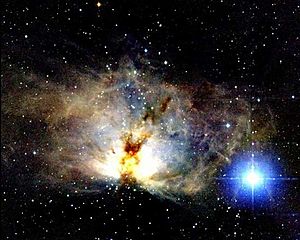Alnitak facts for kids
Alnitak is a very bright star system found in the Orion constellation. It is also known as Zeta Orionis. Alnitak is one of the three stars that form the famous Orion's Belt, a well-known pattern of stars in the night sky.
Contents
What is Alnitak?
Alnitak is not just one star, but actually a triple star system. This means it is made up of three stars that are all orbiting around each other. All three of these stars are very hot and shine with a bright blue light.
The Main Star
The brightest star in this system is called Alnitak A. It is a huge, blue star, much bigger and brighter than our own Sun. Scientists call it an O-type star, which means it is one of the hottest and most powerful types of stars known.
How Big is Alnitak?
Alnitak A is truly enormous! It is about 20 times larger than the Sun. It also shines with the light of about 275,000 Suns. Imagine how bright that would be if it were closer to us!
Alnitak's Companions
The other two stars in the Alnitak system are called Alnitak B and Alnitak C.
- Alnitak B is also a blue star, though it is smaller than Alnitak A. It orbits around Alnitak A.
- Alnitak C is a fainter star, but it is still part of this amazing star family.
Where is Alnitak Located?
Alnitak is part of the constellation Orion, which is one of the easiest constellations to spot in the night sky. Orion looks like a hunter, and Alnitak is the star on the far left of his "belt." The other two stars in Orion's Belt are Alnilam and Mintaka.
Orion's Belt
Orion's Belt is a famous asterism (a recognizable pattern of stars) that helps people find the Orion constellation. It is a great starting point for finding other interesting objects in the sky, like the Orion Nebula.
Why is Alnitak Important?
Alnitak is important to astronomers because it is a very bright and massive star. Studying stars like Alnitak helps us understand how giant stars are born, how they live, and how they eventually end their lives. Its strong light also helps to light up nearby clouds of gas and dust, making them visible to telescopes.
Images for kids
-
Orion's Belt with Alnitak on the left
See also
 In Spanish: Alnitak para niños
In Spanish: Alnitak para niños



